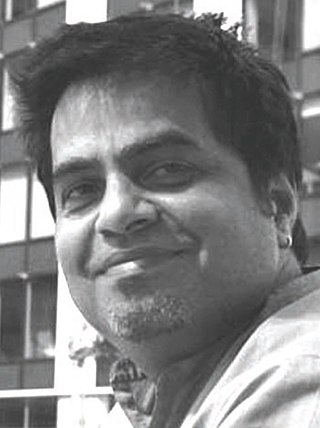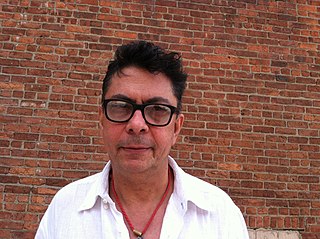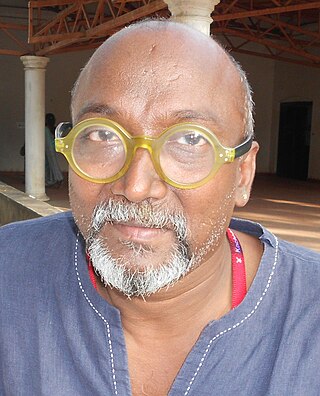
Ranjit Hoskote is an Indian poet, art critic, cultural theorist and independent curator. He has been honoured by the Sahitya Akademi, India's National Academy of Letters, with the Sahitya Akademi Golden Jubilee Award and the Sahitya Akademi Prize for Translation. In 2022, Hoskote received the 7th JLF-Mahakavi Kanhaiyalal Sethia Award for Poetry.
T. V. Santhosh is an Indian artist based in Mumbai. He obtained his graduate degree in painting from Santiniketan and master's degree in Sculpture from M.S. University, Baroda. Santhosh has acquired a major presence in the Indian and International art scene over the last decade with several successful shows with international galleries and museums. His earlier works tackle global issues of war and terrorism and its representation and manipulation by politics and the media. Santhosh's sculptural installation "Houndingdown" was exhibited in Frank Cohen collection ‘Passage to India’. Some of his prominent museum shows are ‘Aftershock’ at Sainsbury Centre, Contemporary Art Norwich, England in 2007 and ’Continuity and Transformation’ show promoted by Provincia di Milano, Italy. He lives and works in Mumbai.

Amar Kanwar is an Indian filmmaker. His work challenges the limits of the medium in order to create complex narratives traversing several terrains such as labour and indigenous rights, gender, religious fundamentalism and ecology.

Sudarshan Shetty is a contemporary Indian artist who has worked in painting, sculpture, installation, video, sound and performance. He has exhibited widely in India and more recently he has become increasingly visible on the international stage as an important voice in contemporary art. His work has been exhibited at the Fukuoka Asian Art Museum, Fukuoka, Japan, and the Tate Modern, London, England. The artist has been a resident at the Mattress Factory, Pittsburgh, United States, and was a Ford Foundation Fellow at the New School for General Studies, New York.

Chittrovanu Mazumdar is a contemporary Indian artist of Bengali-Indian and French descent. Mazumdar has been described as a "conceptual artist" and a "post-structuralist" while some critics consider it difficult to classify his oeuvre into a single artistic tradition or even into any consistent genre of his own. Mazudmar has referred to himself as an "expressionist painter" but has also said he generally prefers not to use "a particular word to qualify" his work because it comprises different kinds of media and forms, and that art is more interesting when fully given over to the viewer's own experience rather than constrained by the prescriptive power of labels.

Riyas Komu is an Indian multimedia artist and curator based in Mumbai. He has invested his time in art education and developing art infrastructure in India. Komu's works are inspired by social conflicts and political movements and topics like migration and displacement. His hyper-realistic oil portraits of people resemble socialist-realist propaganda art, with one of his portraits titled Why Everybody should Look Like Mao.

Madhusudhanan is an Indian film maker and artist, also known as K. M. Madhusudhanan. His debut feature film, Bioscope has received many awards. He is working with different media in art, including sculpture, printmaking installation art and film.

Bose Krishnamachari is an Indian painter and art curator based in Mumbai, India.

Rajeeb Samdani is a Bangladeshi industrialist and art collector. As of 2021, he is the managing director of Golden Harvest Group, a Bangladeshi conglomerate, and the founder and trustee of Samdani Art Foundation which produces the Dhaka Art Summit.
Dhaka Art Summit is an art summit held in Dhaka, Bangladesh and is organised by Samdani Art Foundation, a non- profit art infrastructure development organisation founded by Nadia Samdani. and Rajeeb Samdani in 2011.

The Samdani Art Foundation is a private art foundation founded in 2011 in Dhaka, Bangladesh that aims to increase artistic engagement between the art and architecture of Bangladesh and the rest of the world. It is best known for producing the bi-annual Dhaka Art Summit, which is the highest daily visited contemporary art exhibition in the world, welcoming over 477,000 visitors in its fifth edition in February 2020. It completed its sixth edition in 2023. The foundation produces education programmes and exhibitions across the year in collaboration with Bangladeshi and international institutions and is one of the most active art institutions in South Asia.

Suresh K. Nair is an artist based in Banaras. Nair obtained his national diploma in mural painting from the Institute of Mural Painting Guruvayur, Kerala under the guidance of Mammiyur Krishnan Kuty Nair. He was inspired by the works of Rabindranath Tagore, Nandalal Bose, Benode Behari Mukherjee and Ramkinker Baij and continued his studies at the Department of Painting, Visva Bharati University, Santiniketan. Nair has acquired a presence in the Indian and international art scene over the last decade with several shows organized by regional and international galleries and museums, and created many murals in India and abroad. His early works are based on Kerala murals, both in terms of technique and ideas. One of his modern paintings, ‘Cosmic Butterfly" is owned by Essl Museum, Vienna, Austria since 2010. His works were exhibited in the US, Spain, and Canada, and his awards include the Elizabath Green Shield Foundation Scholarship (1999) of Canada; Fulbright Fellowship ( 2006–07) for an Educational Exchange Program at Tyler School of Art, Temple University, Philadelphia under Professor Nicholas Kripal; and the State Award of Kerala Lalithkala Akademi, Ministry of Culture, Government of Kerala.
Sheela Gowda is a contemporary artist living and working in Bangalore. Gowda studied painting at Ken School of Art, Bangalore, India (1979) pursued a postgraduate diploma at Visva-Bharati University, Santiniketan, India (1982), and a MA in painting from the Royal College of Art in London in 1986. Trained as a painter Gowda expanded her practice into sculpture and installation employing a diversity of material like human hair, cow-dung, incense and kumkuma powder. She is known for her 'process-orientated' work, often inspired by the everyday labor experiences of marginalized people in India. Her work is associated with postminimalism drawing from ritualistic associations. Her early oils with pensive girls in nature were influenced by her mentor K. G. Subramanyan, and later ones by Nalini Malani towards a somewhat expressionistic direction depicting a middle class chaos and tensions underplayed by coarse eroticism. She is the recipient of the 2019 Maria Lassnig Prize.
SiGNS Film Festival is one of the short film and documentary film festivals in India. The tenth edition was conducted in October 2018 in association with the Kochi-Muziris Biennale
Rohini Devasher is an Indian contemporary artist.

Shalini Passi is an Indian art collector, and philanthropist based in New Delhi.
The Kochi-Muziris Biennale 2018 was the fourth edition of the Kochi-Muziris Biennale, an international exhibition of contemporary art held in Kochi, Kerala. This edition which was curated by Anita Dube began on 12 December 2018 and ended on 29 March 2019. Like the previous editions, Aspinwall House, Pepper House, Kasi Art Cafe, Cabral Yard, David Hall are the main venues of this biennale. This biennale was inaugurated by the Chief Minister of Kerala, Pinarayi Vijayan. The Kochi-Muziris Biennale is an initiative of the Kochi Biennale Foundation with support from the Government of Kerala.
Shubigi Rao is an Indian-born Singaporean contemporary artist and writer known for her long-term, multidisciplinary projects and installation works that often use books, etchings, drawings, video, and archives. Her interests include archaeology, libraries, neuroscience, histories and lies, literature and violence, and natural history. Rao has exhibited internationally, presenting work at the 59th Venice Biennale in 2022, 10th AsiaPacific Triennial in 2021, 10th Taipei Biennial in 2016, the 3rd Pune Biennale in 2017, the 2nd Singapore Biennale in 2008, as well as the 4th Kochi-Muziris Biennale in 2018.

Sameer Kulavoor is an Indian contemporary artist and founder of one of the earliest specialised design studios in India, Bombay Duck Designs.
K R Sunil is a visual artist hailing from Kodungallur, Kerala. He is an alumnus of the College of Fine Arts, Thrissur, where he developed his passion for photography. Sunil's work primarily focuses on human life; often ethnographic portrayals set against the backdrop of social and environmental issues. The recurring themes in his art documentation include the sea, maritime history, and climate change. The powerful, investigative representation of common people's struggles in a complex society through his work intents to inspire social change and bring attention to important issues. Sunil has received multiple awards for his series on various socio-relevant topics. For instance, his series titled 'Chronicle of a Disappearance,' which explored the dwindling ponds of Kerala, won him the India Habitat Photosphere Award in 2016. His 'Vanishing Life Worlds' series, which depicted the lives of the old port city of Ponnani, was exhibited at the Kochi Muziris Biennale in 2016. Additionally, his 'Manchukkar - The Seafarers of Malabar' series, which documented the last surviving group of dhow workers along the Malabar coast, was exhibited at the Uru Art Harbour in Kochi in 2018 and at the Clarinda Carnegie Art Museum, USA in 2021, while also getting printed by a Swiss publication the same year. Sunil's series 'Home' explores the impact of climate change on coastal homes and livelihoods. It was part of exhibitions by the Kochi Muziris Biennale Foundation at Kochi and Alappey in 2021. Furthermore, his photography series titled 'Chavittu Nadakam: Story Tellers of the Seashore' sheds light on the lives of Dalit Christian performers of the age-old art form Chavittu Nadakam and how climate change affects them. He has participated in the curatorial exhibition of Mattancherry by artist and curator Riyas Komu. Mattancherry photography series gazes the subaltern livelihood with a concrete ethnographic document to the contemporary cultural historiography Kerala. Mattancherry Island is a major hub of many waves of sea root connections from various parts of the world.
























